Magazine
Design incorporates objects, people,
ideas based on the small pleasures of everyday life.
Meet your Beautiful design world with the DDP Design Fair.
-
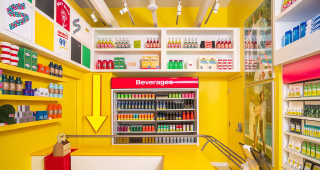
Changing Consumer Perception of The Burgeoning Cannabis Industry with Store Design
Superette x Emily Robin DesignThere are numerous nicknames and slang for marijuana — also a raw material used for textiles and pharmaceuticals — such as weed, grass, pot, hashish, hemp, cannabis and Mary Jane. In South Korea, marijuana has been treated as an illegal drug since the 1970s, however, since the government legalized medical use of cannabis in 2018, the import and use of products containing cannabis for medicinal purposes is permitted with a prescription from a doctor based on the patient’s decision.Amidst the debate over its role as a tension reliever or a hallucinogen, more and more countries are legalizing cannabis as a medical supplement and a recreational substance since it could be used as an effective medicinal supplement. Going along with this trend, many cannabis products that cater to consumer preferences and interests are appearing on the market and emerging as a new high-value industry.After Canadian government legalized recreational marijuana in 2018, cannabis retail brand Superette based in Toronto, Canada, was founded in 2019. Superette's sales have steadily increased, and Superette is currently operating six retail stores in Canada and planning to expand into the US market next year by keeping up the momentum.The store's interior design is a collaboration between Superette’s in-house design team and Emily Robin Design Studio based in British Columbia, Canada. You will see oversized and bold red-and-white checkerboard tile flooring, vibrant primary colors and large graphic elements with products displayed like a combination of a local grocery store and a drug store, bringing back the retro pop vibe of the 1960s.
2021-12-033,305 -
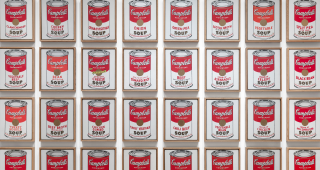
The World’s Most Famous Soup Can is Getting a Redesign for the Digital Age
Campbell’s Soup prepares for the era of metaverse with its new packaging designThe Campbell’s soup can, which was transformed into a work of art by American pop artist Andy Warhol in 1962, redesigned its packaging for the first time in 50 years.Just as a vast array of products are neatly organized to arouse consumers’ visual attention and desire and make them experience vertigo with infinite freedom of choice, 32 types of Warhol’s Campbell’s soup cans wrapped in red-and-white paper labels present a gratifying moment when the boundaries between a supermarket and a gallery become unclear.On July 27, 2021, Campbell’s Soup Company unveiled the refreshed label design of Campbell’s Soup and dropped 100 pieces of limited-edition digital art with NFTs (non-fungible tokens) based on the redesigned label via OpenSea, a marketplace for digital art.The logo was redesigned by graphic designer and illustrator Sophia Chang. The “O” slanted to the left from the “SOUP” font in Campbell’s soup label was positioned upright and changed to a two-dimensional capital letter in gold. An image that represents the taste of the soup was also added to the side. For example, the label of Campbell’s signature tomato soup can includes an image of a tomato. Campbell partnered with Ntwrk and Aerial to convert Warhol’s Campbell’s soup cans into NFTs.
2021-11-16638 -
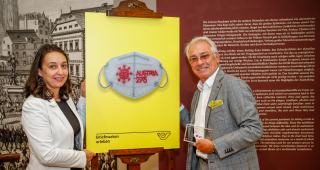
Stamp, A Record of Historical Events
Austria’s Mask, expected to be one of the collectiblesAustrian Post (Österreichische Post) issued a special edition post stamp in the shape of a mini FFP2 mask to commemorate the FFP2 mask mandate on Sep. 15, 2021. The FFP2 mask used in the EU is a medical mask equivalent to N95 mask or Korea's KF94 mask.The stamp is expected to be one of the collectibles that will grab the attention of collectors who are highly interested in stamps with unique and rare designs. In October 2020, Austrian Post issued 30,000 limited edition stamps in the shape of a roll of toilet paper with hygiene practices for COVID-19, reflecting the social phenomenon of panic-buying of toilet paper during the early stage of the COVID-19 outbreak.From last year until now, for about a year and a half, face masks have become a necessity so we can hardly imagine our daily lives without them. Austrian Post CEO Georg Pölzl said, “Stamps have always been a reflection of the events of the times.” COVID-19 is the most representative symbol and cultural evidence of the current situation and the challenge people around the world are facing together.
2021-11-16299 -
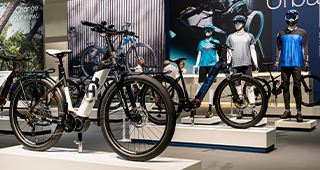
Germany’s 2021 IAA Motor Show
Predicting the Future of Two-wheeled MobilityGermany’s International Motor Show (Internationale Automobil Austellung or IAA), which used to be held in Frankfurt every year, has been held at the Munich Exhibition Center for six days from September 7 to 12 and been rebranded “IAA Mobility” after the postponement due to the COVID-19 pandemic and overcoming the global crisis in the automotive industry.Despite the restrictions on international travel due to the COVID-19 pandemic, a noticeable decline in visitors, the absence of global automakers such as GM, Toyota and the Stellantis Group (the parent company of Peugeot) and a 30 percent of empty booths, German carmakers including Volkswagen, BMW, Mercedes-Benz and Audi have ended the era of diesel and internal combustion engine powered vehicles and predicted the future of the automobile industry by showcasing eco-friendly electric vehicles for various customer groups with a wide range of prices.In parallel to that, the media and the general public have shifted their attention to other aspects of mobility, electric two-wheelers, such as e-bike, pedelec, e-scooter and e-kick scooter. Small and medium-sized electric two-wheeled mobility manufacturers have undeniably emerged as the stars of this year's IAA Mobility event. It is declared that the mobility of the future is moving to practical and eco-friendly two-wheeled lifestyle vehicles rather than flashy luxury cars.BMW Motorrad Vision AMBY. © BMW Group
2021-10-12380 -

IKEA Vienna Unveils New Retail Concept
A Sustainable World: Presenting a Blueprint for the Future of RetailIKEA — the world's largest Swedish DIY furniture and interior company — opened a new store in Vienna, Austria on August 26. The new IKEA concept store finally opened its doors after going through extensive consultations with the Vienna’s municipal government and the entire process from planning to initiation to construction over the past 10 years with an investment of 140 million euros. What is noteworthy is that the new concept store presents a blueprint for the future of retail by further evolving its existing businesses — what we are familiar with — including furniture, interior and restaurant.One of the striking features of the new IKEA concept store is that it is accessible only by public transport or personal mobility devices (e.g., single-person transportation vehicle such as a bicycle or kick scooter or walking). According to IKEA's new concept, the store is designed for “urban shoppers who come without bringing their car”. It has no parking spaces at all.Customers who are ready to leave the store after browsing the store’s shelves and finishing their shopping can use smartphones to self-checkout and take the purchased items with them or place an order for delivery and leave without the hassle of waiting in a long line to check out. To prevent carbon dioxide emissions, the purchased items are delivered straight to the customer’s doorstep by bicycle or electric car.The building of the new IKEA concept store also reflects the new era of sustainability. It is said that 160 trees and gardening plants surrounding the building keep the indoor temperature cool on the hottest days of summer and reduce CO2 emissions in the atmosphere by 1,000 tons per year.All images courtesy: IKEA.
2021-10-12653 -
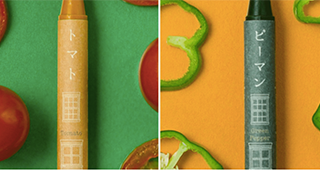
Plant-based Crayons Made from Vegetables and Fruits
Oyasai CrayonsJapanese company Mizuiro Inc. and designer Naoko Kimura came together to work on its latest sustainable project for kids. Mizuiro Inc. — a manufacturer of plant-based stationery — developed Vegetable Crayon®, a proprietary technology that extracts useful materials from Japanese rice and discarded vegetables. Mizuiro Inc. produces office stationery supplies and crayons for parents and children.Oyasai Crayons, a crayon collection for kids, come in 20 different colors, including 10 shades made with natural pigments extracted from fruits and vegetables. The 10 colors of plant-based crayon are red, orange, purple, beige, green, brown, yellow, purple, light green and gray, which are made from fruits and vegetables including apple, carrot, purple potato, Japanese yam, leek, burdock, corn, cassis, bamboo and charcoal. Oyasai Crayons meet the JIS standard, which is an inspection that ensures a benchmark for crayon strength. They have earned the European standard toy safety EN71-3: 2013 certificate as a result of a strict safety inspection. The company has also received numerous design awards for the product. Additionally, most of the crayons in the market are made of paraffin wax, which contains petroleum, and are unsafe for children if they accidentally eat them but also harmful to the environment as they are not biodegradable. Any parent with kids will know babies and toddlers put everything in their mouths. This is how Mizuiro Inc. first came up with the idea of “Oyasai Crayons”, both a stationery and a toy for children that is safe and harmless for human bodies and recycles discarded vegetables and fruits.While all ingredients are food-grade and deemed safe and healthy for kids and adults as they are extracted from vegetables and fruits, they are not edible. It is a safer and more eco-friendly option for children to play with since crayon is a writing utensil that is in direct contact with children's bodies for a long time and a toy children is likely to put in their mouths. © 2014-2021 Mizuiro Inc.
2021-09-24674 -
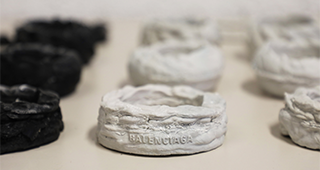
Plastic Waste Turned into Materials for Fashion
Reducing Plastic Use with Designers’ Innovative ApproachesSince the outbreak of the COVID-19 pandemic, the global apparel industry has been actively participating to drive recycled plastic innovation.Most consumers may not think of plastic when they think of fashion. In fact, 63 percent of apparel products we buy and wear are made of virgin plastic, and it is said that the global apparel industry uses a whopping 65 million tons of virgin plastic per year. In addition, antioxidants, dyes and fire retardants in fabrics are also used as additives that break down plastic into smaller fragments. These various derivatives end up in the rivers, oceans and food chains around us in the form of chemicals and microplastics and enter human bodies.In order to tackle the problem of plastic pollution caused by the fashion industry, global apparel brands including Stella McCartney, Everlane, Adidas, Patagonia and H&M are recycling clear PET drinking water bottles and fishing rods that are thrown away and collected from the ocean and using them to produce new products.For example, Everlane's ReNew Collection has seen such a positive response from customers by launching eco-friendly swimwear and socks made of recycled plastic in cooperation with innovative textile manufacturers that process plastic waste into recycled synthetic yarns that have been sterilized, processed and spun.Hyundai Motors in Korea has been collaborating with famous fashion designers since 2020 and once worked on an upcycling project to transform used airbags into clothes. Meanwhile, Israeli plastic upcycling startup Remeant developed a technology that converts disposable plastic products that are difficult to recycle such as bubble wrap into lightweight and waterproof synthetic leather.There are companies that take a step further. More and more companies are using sustainable fabrics that are blended with recycled plastic and natural plant extracts. For instance, Juch, the French eco-friendly sneaker brand, launched vegan leather shoes that are manufactured by combining shoelaces recycled from ocean plastic waste, sustainably sourced cork, natural rubber soles and inner insoles made of natural latex, wool, wood and cornstarch to meet the needs of consumers and stakeholders who want eco-friendly and sustainable products.However, recycling plastic waste and consuming upcycled apparel made from plastic cannot solve the fundamental problem of plastic waste pollution on our planet.According to a consumer survey, consumers think that about half of the clothes sold by fast fashion brands are made of plastic. In fact, 90 percent of clothes sold in the industry use virgin or recycled plastic. In addition, about 500,000 microfibers are released into the water system and make their way into the oceans each time we wash our clothes in a washing machine, an average 6 kg wash.There are still many consumers who purchase cheap and convenient fast fashion clothing. Amid this continuing trend, fashion and plastic are inextricably linked. Given that reality, the innovative efforts of designers should continue to come up with solutions that can reduce the use of plastic, whether made from virgin or recycled plastic. ‘From Cars to Couture’ Hyundai Re:Style 2020 x Selfridges Department Store’s Fashion Line.Balenciaga x Designer Shahar Livne. Fossil-like Jewelry Line Created Through the Collaboration. © Shahar Livne Design.Juch Paris’ Eco-friendly, Sustainable and Comfortable Sneakers. © 2021, JUCH.
2021-09-24781 -
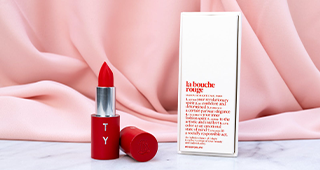
When La Bouche Rouge Meets Clean Beauty
Beauty & Recycled Ocean PlasticLa Bouche Rouge declares that creativity and collaboration can solve one of humanity's problems, ocean pollution.This small beauty product called lipstick, which used to be an icon for desire in pop culture, has been reborn as a symbol of sustainable recycling practice and consumer conscience. La Bouche Rouge’s Refillable Lipstick made its debut in the spring of 2018 at The Webster, a luxury concept store in New York and has become a cult beauty item of a French clean beauty brand with a mission to save the global environment, while also enhancing people’s beauty and well-being.The beauty industry has long been criticized as a key culprit in creating a large amount of non-biodegradable waste from production to consumption and disposal due to the mass production of plastic packaging and its high dependence on various ingredients derived from petroleum. However, eco-friendly beauty and recyclable cosmetic packaging might seem like an incongruous pair in the consumer’s mind.Since cosmetic products are personal care items that emphasize strict hygiene standards and pleasant use, the beauty industry is still reluctant to join the recyclable packaging trend. French beauty house La Bouche launched La Baume Rose Lipstick with a case made of recycled plastic while communicating the value of responsible consumption based on respect for human beings.La Bomme Rose Lipstick case, which has been processed and recycled from ocean plastic waste, is plastic-free and can be reused by repurchasing the refill pack only after finishing a lipstick. It does not contain any polymer ingredient, which is harmful to human body and commonly used in traditional lipsticks. Aside from the lipstick colors, La Bouche Rouge is expanding its product line to include eyeshadow palettes and powder cases and presenting new designs by making the packaging worth keeping. © 2021 LA BOUCHE ROUGE
2021-09-24579







